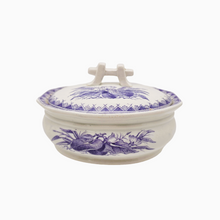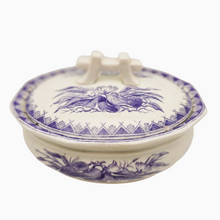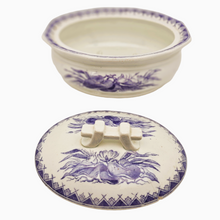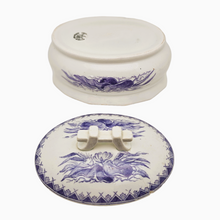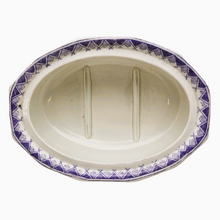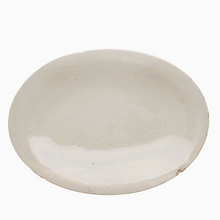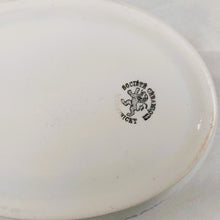
Maastricht earthenware soap box, decorated with floral (bindweed decoration) and geometric patterns in creamy white and purple blue. The handle is Japanese-inspired. The object must date from the end of the 19th century, beginning of the 20th century.
On the back is a stamp “Maestricht ceramic company” surrounding a lion. " The entrepreneurs Winand Nicolaas Clermont and Charles Chainaye founded a pottery in 1851 in the Wijck district of Maastricht. Their company was taken over in 1859 by the Belgian engineer Guillaume Lambert and transformed into a limited partnership. Four years later, it became a limited liability company, generally known as “Société Céramique”.
Under the direction of Victor Jaunez (1863-1913), the engineer PJ Lengersdorff (1902-1915) and Edgar Michel (1915-1954), the Société Céramique prospered and became the main competitor of Petrus Regout's company. , renamed Sphinx in 1899. 1900 the products of the Ceramic Company rival those of the Sphinx in price and quality.
In the 20th century, the Ceramic Company focused more and more on the production of sanitary ware. In 1958, the company merged with its Maastricht competitor, Sphinx (formerly Petrus Regout). The factory premises were demolished in the early 1990s to make way for a new prestigious housing estate, called Céramique” (source: https://geheugen.delpher.nl).
The box is in good general condition, note: on the inside of the lid, 3 mini-chips and 1 slight crack which do not detract from the beauty of this object.
It can hold your little jewels or treasures and will be very decorative in a bedroom or bathroom. It matches the comb box which is sold separately, but its identical decor is blue and white and not purple and white.
Dimensions: length 15.5 cm, width 11.5 cm, height +/- 10 cm, weight 402 g.
Free delivery for Belgium, the Netherlands, Luxembourg and France.
Careful shipping.







